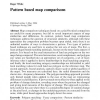641 search results - page 105 / 129 » Collusion set detection using graph clustering |
SIGIR
2005
ACM
14 years 2 months ago
2005
ACM
In this paper we use a Unified Relationship Matrix (URM) to represent a set of heterogeneous data objects (e.g., web pages, queries) and their interrelationships (e.g., hyperlinks...
SDM
2012
SIAM
11 years 11 months ago
2012
SIAM
Multiple data sources containing different types of features may be available for a given task. For instance, users’ profiles can be used to build recommendation systems. In a...
BMCBI
2004
13 years 8 months ago
2004
Background: Recent genomic and bioinformatic advances have motivated the development of numerous network models intending to describe graphs of biological, technological, and soci...
JGS
2006
13 years 8 months ago
2006
Map comparison techniques based on a pixel-by-pixel comparison are useful for many purposes, but fail to reveal important aspects of map similarities and differences. In contrast, ...
SADM
2010
13 years 7 months ago
2010
The goal of frequent subgraph mining is to detect subgraphs that frequently occur in a dataset of graphs. In classification settings, one is often interested in discovering discr...


